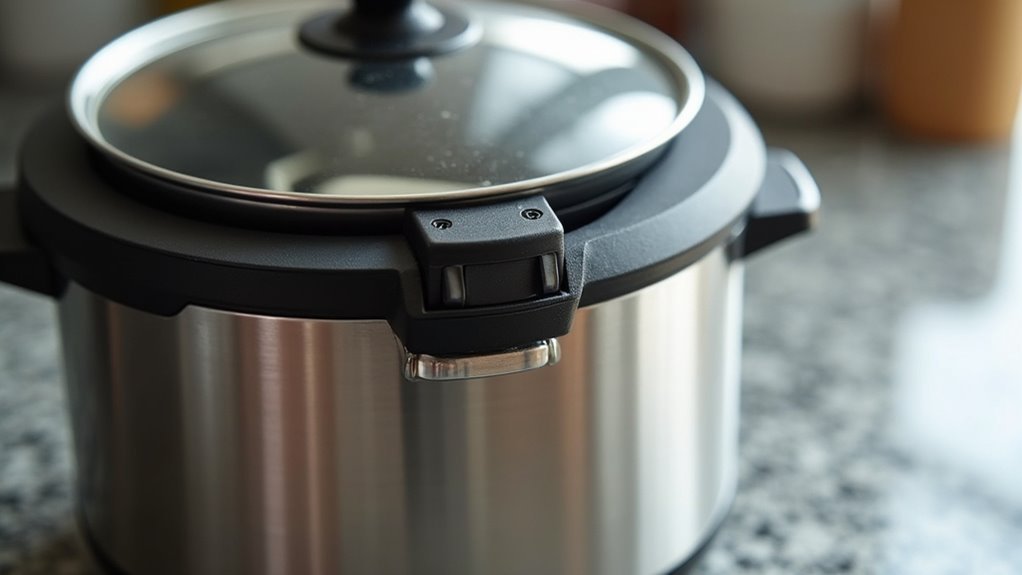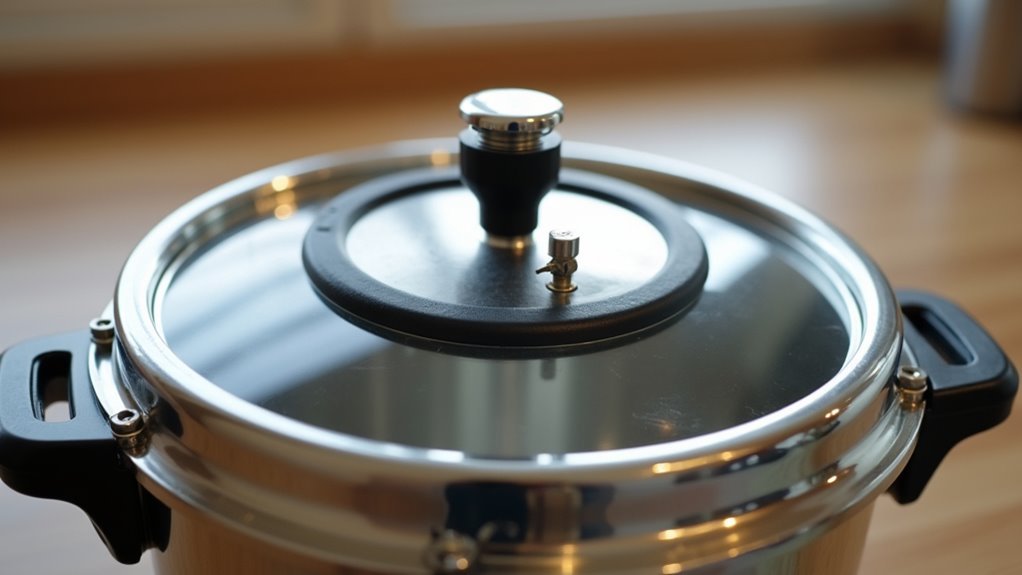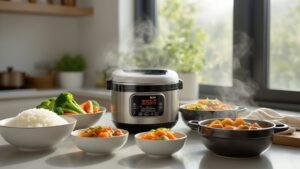Most people don’t realize that electric cooker lids actually use multiple locking points—not just one—to create that perfect seal we rely on for pressure cooking. We’ve noticed that understanding these mechanisms can, well, make the difference between a perfectly cooked meal and a kitchen disaster. The way these systems work together is more intricate than you’d expect, and honestly, there’s some fascinating engineering happening right under our noses that most of us never think about.
Table of Contents
ToggleHow Electric Rice Cooker Locking Systems Function
When we’re talking about electric rice cookers, the locking lid mechanism is actually one of those brilliant little engineering solutions that we probably don’t think about much – until it stops working, that is.
The lid lock works by creating a tight seal that prevents steam release during cooking. This pressure buildup is essential for peak cooking results.
Most electric rice cookers include safety features like automatic latches and pressure indicators that show when it’s safe to open.
Regular maintenance of the locking mechanism guarantees user safety and, well, keeps everything functioning properly for years.
Types of Locking Mechanisms in Modern Rice Cookers
Since we’ve covered how these locking systems work, let’s explore the different types you’ll actually encounter when shopping for a rice cooker.
Most models feature a basic one-touch mechanism to secure the lid during the cooking process.
Well, you’ll also find pressure cooker safety locks that won’t open until internal pressure drops completely—think of it like a safety valve for high temperatures.
Advanced units include secondary locking mechanisms for extra security.
These durable mechanisms handle heat as necessary while the release valve manages pressure buildup effectively.
Safety Features of Electric Rice Cooker Lid Locks

While we’ve looked at the different locking types, what really matters is how these systems keep us safe in the kitchen.
The locking lid mechanism prevents accidental openings during the cooking process, which—well, nobody wants hot steam shooting out unexpectedly. Most cookers use a pressure sensor that automatically engages once cooking starts, maintaining proper temperature control.
The safety release valve is probably the most vital feature, allowing steam to escape safely without building dangerous pressure.
A robust locking mechanism should be user-friendly too. Many models include an indicator showing when it’s properly secured, giving us that extra peace of mind. Additionally, understanding how altitude impacts cooking can further enhance the safety and efficiency of your rice cooker operation.
Common Issues With Rice Cooker Locking Mechanisms
Why do rice cooker lids sometimes seem to have a mind of their own?
Well, several common issues can plague these locking mechanisms. Misalignment tops our list—when the locking lid doesn’t sit properly, it won’t seal securely, affecting cooking results.
The safety lock can malfunction too, staying engaged even after pressure drops.
We’ve found that food debris often obstructs the mechanism, which is why regular cleaning is essential.
When components become sticky or—actually, let me rephrase that—when they start feeling rough or difficult to operate, it usually means replacement time for safe rice cooker operation.
Maintenance and Care for Lid Locking Systems

Proper maintenance isn’t just a suggestion—it’s the difference between a rice cooker that serves you faithfully for years and one that becomes a kitchen hazard.
We should inspect the lid locking mechanism regularly for wear or damage. A faulty lock can lead to dangerous pressure release during cooking, which—well, nobody wants that.
Clean the locking system thoroughly to prevent food buildup that hinders functionality. Make sure the mechanism can engage properly for a firm fit.
Most cookers need periodic testing to guarantee the lid lock holds securely under pressure, maintaining safety standards we all depend on.
Troubleshooting Faulty Electric Rice Cooker Locks
Three common culprits usually lurk behind a stubborn rice cooker lock that won’t cooperate.
First, we’ll check the locking mechanism alignment—if your lid isn’t sitting just right, the locking latch won’t engage properly.
Next, inspect for debris or damage around the latch itself. A malfunctioning pressure release valve can also throw things off, actually preventing proper sealing.
Don’t overlook the gasket either; when it’s worn, steam leakage occurs and the cooker can’t maintain pressure for locking.
Your user manual probably has model-specific troubleshooting steps we’d recommend following for the best results.
Frequently Asked Questions
How to Open a Locked Cooker Lid?
We’ll start cooker lid troubleshooting by checking pressure release valve operation, then examine safety release mechanisms and lid alignment. If problems persist, consult user manual guidelines for emergency unfastening methods.
Why Is My Cooker Lid Not Closing?
Like Cinderella’s glass slipper, your lid won’t fit if there’s lid alignment issues or gasket wear problems. We’ll check your pressure release valve, steam vent blockage, and follow troubleshooting steps from user manual guidelines.
What Are the Parts of a Pressure Cooker Lid?
We’ll identify key pressure cooker parts: the lid locking system, rubber gasket, safety valve function, pressure indicator features, and handle design. These lid sealing mechanism components work together ensuring safe operation and proper sealing.
How to Lock a Pressure Cooker Lid?
Like pieces of a puzzle, we’ll align the lid perfectly with the base, then twist to engage the locking mechanisms until it clicks securely—ensuring proper steam management and safety features activate before cooking.






